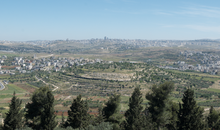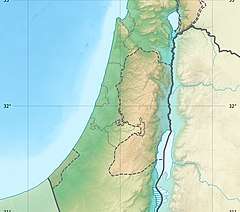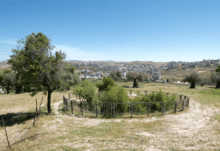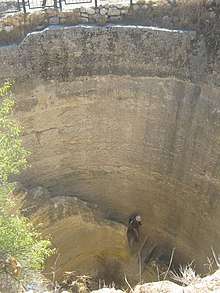Gibeon (ancient city)
Gibeon (Hebrew: גִּבְעוֹן, Standard Hebrew Giv‘ōn, Tiberian Hebrew Giḇʻôn; in LXX Ancient Greek: Γαβαων) was a Canaanite and Israelite city north of Jerusalem. According to Joshua 10:12 and Joshua 11:19, the pre-conquest inhabitants of Gibeon, the Gibeonites, were Hivites; according to 2 Samuel 21:2 they were Amorites. The remains of Gibeon are located on the southern edge of the Palestinian village of al-Jib.
 | |
 Shown within West Bank | |
| Location | Al Jib |
|---|---|
| Region | West Bank |
| Coordinates | 31.847451°N 35.183351°E |
| Site notes | |
| Excavation dates | 1956 - 1962 |
| Archaeologists | James B. Pritchard |
| Condition | In ruins |
Biblical account
Canaanite Gibeon
After the destruction of Jericho and Ai, the people of Gibeon (Hivites) sent ambassadors to trick Joshua and the Israelites into making a treaty with them. According to the Bible, the Israelites were commanded to destroy all inhabitants of Canaan. The Gibeonites presented themselves as ambassadors from a distant, powerful land. Without consulting God (Joshua 9:14), Israel entered into a covenant or peace treaty with the Gibeonites. The Israelites soon found out that the Gibeonites were actually their neighbours, living within three days walk of them (Joshua 9:17) and Joshua then realised that he had been deceived; however, he kept the letter of his covenant with the Gibeonites to let them live in exchange for their servitude, deciding to have them assigned as woodcutters and water-carriers and condemning (cursing) them to work forever in these trades (Joshua 9:3-27). Theologian John Gill suggests that this curse was a particular example of the curse which Noah inflicted on all of Canaan:
- Then he (Noah) said:
- "Cursed be Canaan; a servant of servants he shall be to his brethren".[1]
In retaliation for allying with the Israelites, the city was later besieged by a coalition of five other Amorite kings led by Adonizedek, king of Jerusalem, along with Hoham of Hebron, Piram of Jarmuth, Japhia of Lachish, and Debir of Eglon. The Gibeonites appealed to Joshua, who led the subsequent victory over the Amorites amid miraculous circumstances, including deadly hailstones and the suspension of the movement of the sun and moon, until the Amorites were completely defeated (Joshua 10:1–15).[2]
As an Israelite city
Biblical record
In the Book of Joshua, ancient Jib or Gibeon is described as "a large city, like one of the royal cities" located in the tribal territory of Benjamin (Joshua 18:25). It was given as a Levitical city (Joshua 21:17).
The flat and fertile land with many springs which surrounds it gave rise to a flourishing economy, attested to in the large number of ancient jars and wine cellars discovered there. The jars could hold 45 litres of wine each and 66 wine cellars two meters deep and dug out of rock have been unearthed in Jib.[3] In the first Book of Chronicles, Jeiel is mentioned as the "father of Gibeon" and is an ancestor of King Saul.[4]
Following the capture of the Ark of the Covenant by the Philistines, the remaining part of the Tabernacle of the LORD was moved from Shiloh to the "great high place" in Gibeon (1 Samuel 4:1-22, 1 Chronicles 21:29).
2 Samuel 21:2 indicates that King Saul pursued the Gibeonites and sought to kill them off "in his zeal for the children of Israel and Judah" (2 Samuel 21:5). Following Saul's death, fighting between the soldiers of Joab and those of Abner took place beside the Pool of Gibeon (2 Samuel 2:12). It was in this area that King David conquered the Philistines (2 Samuel 5:25 and 1 Chronicles 14:16).
David then became king of the United Monarchy. Much later, after the death of his rebellious son Absalom and his restoration to the throne, Israel was visited by a three-year drought which led David to ask God what was wrong. The drought was then revealed to be divine judgement against King Saul's decision to completely exterminate the Gibeonites (2 Samuel 21:1), in his "zeal for Israel and Judah". The blame for this genocide is also attributed to Saul's family. This event is not itself recorded in the biblical narrative,[5] although Gill refers to a Jewish tradition linking this slaughter to the slaughter of the priests at Nob (1 Samuel 22:6-19).[6] David asked the surviving Gibeonites what he could offer to make amends. In retribution, they asked for seven of Saul's male descendants to be given to them to kill, seven signalling the sign of completion. David handed over Armoni and Mephibosheth, two of the sons of Saul and the five sons of Merab (Saul's daughter) to the Gibeonites, who hanged them. He saved Jonathan's son, also called Mephibosheth, from this peril because of his covenant with Jonathan (2 Samuel 21:1-9). Amasa was also killed here (2 Samuel 20:8).
On his accession to kingship, King David's son Solomon met with all Israel's leaders at Gibeon and offered one thousand burnt offerings (1 Kings 3:4, 2 Chronicles 1:6). On this occasion God appeared to him in a dream (1 Kings 3:5) and granted him wisdom (1 Kings 3:12, 2 Chronicles 1:7-12).
Hananiah, son of Azzur came from this city (Jeremiah 28:1).
After the exile of the Israelites to Babylon, Gibeon belonged to Judea.[7]
Significance
1 Chronicles 16:39 suggests that worship before the tabernacle at Gibeon continued alongside worship in Jerusalem after David brought the Ark of the Covenant back there, although "nothing ... is said of this in the Books of Samuel".[8] Theologian Hans-Peter Mathys notes that "no other OT book mentions a regular (sacrificial) cult in Gibeon. Its historical authenticity is sometimes supported by the argument that 1 Kings 3:3 (Solomon ... went to Gibeon to sacrifice there; for that was the great high place; a thousand burnt-offerings did Solomon offer upon that altar) confirms its existence and speaks out against it. It is more likely, however, that these four verses were conceived by the Chronicler, [who] ... is at pains to portray an uninterrupted and legitimate (sacrificial) cult spanning the entire period from the desert era (with its tabernacle), including the LORD's residence at Gibeon, right up to Solomon's establishment of the temple in Jerusalem."[9]
In Jewish law
In Rabbinic Judaism, the alleged descendants of the Gibeonites, known as Natinim, are treated differently from ordinary Jews. They may not, for example, marry a Jew by birth. However, a Natin may marry Mamzerim and Gerim.[10] The men of Gibeon, with Melatiah the Gibeonite at their head, repaired a piece of the wall of Jerusalem near the old gate on the west side of the city (Nehemiah 3:7), while the Nethinim dwelt at Ophel on the east side (Nehemiah 3:26).
Archaeology

| ḳbꜣꜥꜣnꜣ[11][12] in hieroglyphs |
|---|
The earliest known mention of Gibeon in an extra-biblical source is in a list of cities on the wall of the Amun temple at Karnak, celebrating the invasion of Israel by Egyptian Pharaoh Shoshenq I (945–924 BCE).[11][13] Josephus placed Gibeon at 40 furlongs from Jerusalem.[14] The 10th-century lexicographer David ben Abraham al-Fasi, identified al-Jib with the ancient city Gibeon, which view was corroborated also by the Hebrew Lexicon compiled by Wilhelm Gesenius and Frants Buhl ("now al-Ǧīb").[15] However, the first scientific identification of al-Jib with the ancient Canaanite city of Gibeon was made by Edward Robinson in 1838. The remains of Gibeon were excavated in six expeditions from 1956 to 1962, led by the University of Pennsylvania archaeologist James B. Pritchard.[2][16][17]
Early Bronze age
Gibeon was founded in the Early Bronze Age (EB),[18] for the excavators discovered 14 EB storage jars beneath the foundations of the Iron Age wall. Other EB remains were discovered at the top of the tel but the stratigraphy had been destroyed by British gunfire during the First World War. It is probable that there was a defensive wall, but this has not yet been found. Tombs cut into the rock on the east site of the hill contained EB jars and bowls, formed first by hand and then finished on a slow wheel. The Early Bronze city was destroyed by fire, but no date has been determined for this destruction.
Middle Bronze age
The Middle Bronze Age is known from shaft tombs on the west of the city: 26 MBI tombs have been found but the crudeness of the pottery they contain indicate that the people may have been nomads camping on an unfortified site. The remains are similar to those found elsewhere at Jericho, Lachish and Megiddo. In MBII, however, a substantial city with finely made pottery was found. 29 MBII tombs have been found, apparently containing multiple burials (as opposed to the single burials of the MBI tombs).
Late Bronze age
No trace of a Late Bronze age city has been found.[19] Only seven tombs are known from the period, but they nevertheless point to a degree of sophistication, as they contained imported Cypriote ware and local potters attempted to copy Mycenaean and Cypriote pottery. It would appear that some, at least, of these tombs had been cut during earlier periods and were being reused.[16][17]
Iron age

During the early Iron Age, a massive wall was constructed around the crown of the hill and a huge pool was cut in the living rock just inside the wall. It is 11.8m in diameter and 10.8m deep, with a spiral staircase of 79 steps cut into the walls of the pool, continuing downwards into a tunnel that provides access to a water chamber 24m below the level of the city. It is possible, but cannot be proven, that this structure is the "pool of Gibeon" of 2 Samuel 2:13. Later in the Iron Age, another tunnel of 93 steps was constructed to a better water source below the city starting from a point near the pool. A second access point to this source from the base of the hill is still in use today.[2][16] This was apparently the city's period of greatest prosperity.
In the 8th and 7th century BCE there was a considerable wine industry there; cellars with room for 95,000 liters of wine have been found. Impressive among these finds are sixty-three wine cellars from the 8th to 7th century BC. Hebrew inscriptions of גבען (GBʻN) on the handles of wine storage jars, most of which were excavated from a large pool matching the biblical description, made the identification of Gibeon secure and a landmark product of biblical archaeology. Pritchard published articles on their production of wine, the Hebrew inscriptions, the rock-cut wine cellars, and the well engineered water conduits that supplied the city water.
Classical Antiquity
From the 6th to the beginning of the 1st century BCE, there is scant evidence of occupation. During the Roman period there was considerable building, including stepped baths and water conduits.[2][16]
Gibeon was possibly a dependency of Jerusalem, and was probably not fortified at the time.
Eusebius, in his Onomasticon, mentions Gibeon (Gabaon) as formerly being inhabited by the Gibeonites, who were a Hivite nation, and that their village was located about 4 milestones to the west of Bethel, near Ramah.[20] The 10th-century lexicographer, David ben Abraham al-Fasi identified al-Jib with the ancient city Gibeon, which view was corroborated also by the Hebrew Lexicon compiled by Wilhelm Gesenius and Frants Buhl ("now al-Ǧīb").[21] and proved by Hebrew inscriptions unearthed in 1956.[16]
At a nearby ruin, built on the southern slope of a ridge at the western side of the al-Jib highland, archaeologists discovered a Hellenistic-Second Temple period dwelling, in which were found a plastered ritual bath with three descending staircases and an industrial zone with lime kilns.[22]
In a 2017 paper, Colin Humphreys and Graeme Waddington suggested that the biblical story of the Israelites' victory against the Amorites over Gibeon, where God made the sun stand still (Joshua 10:12), may be identified with an annular eclipse which occurred on 30 October 1207 BC.[23]
References
| Wikimedia Commons has media related to Gibeon. |
- Gill's Exposition of the Entire Bible on Joshua 9, accessed 26 March 2017; cf. Genesis 9:3–27
- J. B. Pritchard, Gibeon: Where the Sun Stood Still (Princeton University Press, 1962).
- Brooks, 2005, p. 93-94.
- 1 Chronicles 9:35-39
- Jerusalem Bible, note at 2 Samuel 21:2: "The account of these events has not been preserved"
- Gill's Exposition of the Entire Bible on 2 Samuel, accessed 18 August 2017, quoting Babylonian Talmud: Bava Kamma, fol. 119. 1: "For indeed where do we find that Saul slew the Gibeonites? It must therefore be because he slew Nob, the city of the priests".
- Nehemiah 3:7
- Barnes, W. E. (1899), Cambridge Bible for Schools on 1 Chronicles 13, accessed 22 February 2020
- Mathys, H. P., 1 and 2 Chronicles in Barton, J. and Muddiman, J. (2001), The Oxford Bible Commentary, p. 277
- Yebamot 8:3
- Gauthier, Henri (1928). Dictionnaire des Noms Géographiques Contenus dans les Textes Hiéroglyphiques Vol. 5. p. 169.
- Wallis Budge, E. A. (1920). An Egyptian hieroglyphic dictionary: with an index of English words, king list and geological list with indexes, list of hieroglyphic characters, coptic and semitic alphabets, etc. Vol II. John Murray. p. 1043.
- J. Blenkinsopp, Gibeon and Israel: The Role of Gibeon and the Gibeonites in the Political and Religious History of Early Israel (Cambridge University Press, 1972), p. 3.
- Antiquities of the Jews, 7.11.7
- Solomon Skoss, The Hebrew-Arabic Dictionary of the Bible known as Kitab Jami al-Alfaz (Agron) of David ben Abraham Al-Fasi, the Karaite (New Haven: Yale 1936), ‘Introd.’ p. xxxviii.
- E. Stern (ed.), The New Encyclopedia of Archaeological Excavations in the Holy Land, article "Gibeon", Israel Exploration Society & Carta (1993), Vol 2, pp. 511-514.
- J. B. Pritchard, Culture and History, in J. P. Hyatt (ed.) The Bible in Modern Scholarship (Abingdon Press, 1965), pp. 313-324.
- "The Biblical World. A dictionary of Biblical Archaeology", ed. Charles F. Pfeiffer, art. "Gibeon"
- J. B. Pritchard, Gibeon: Where the Sun Stood Still (Princeton University Press, 1962), 157-158.
- Chapmann III, R.L.; Taylor, J.E., eds. (2003). Palestine in the Fourth Century A.D.: The Onomasticon by Eusebius of Caesarea. Translated by G.S.P. Freeman-Grenville. Jerusalem: Carta. p. 41 (s.v. Gabaon). ISBN 965-220-500-1. OCLC 937002750.
- Solomon Skoss, The Hebrew-Arabic Dictionary of the Bible known as Kitab Jami al-Alfaz (Agron) of David ben Abraham Al-Fasi, the Karaite (New Haven: Yale 1936), introd. p. xxxviii.
- Binyamin Har-Even, "Khirbet el-Jafir (West) – A Rural Settlement of the Second Temple Period in the El-Jib Highland", in: Summaries (Part One): Bible, History and Archaeology, pp. 27 - 28
- "Solar eclipse of 1207 BC helps to date pharaohs", OUP.